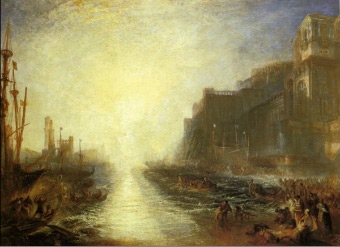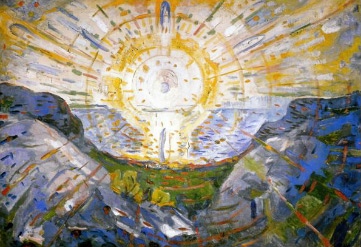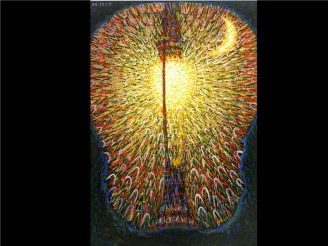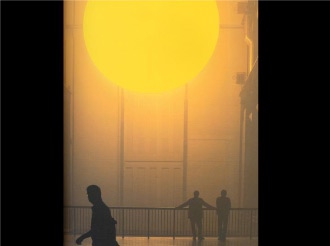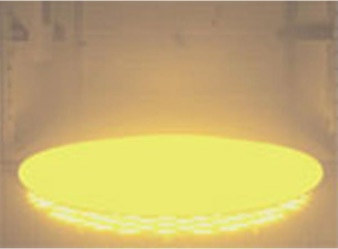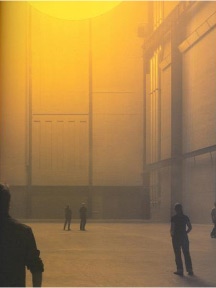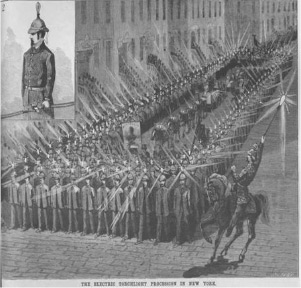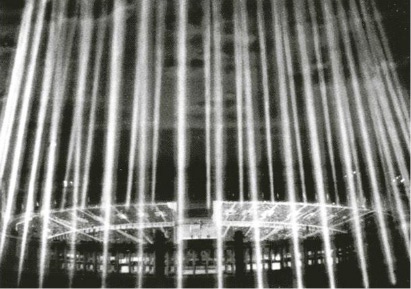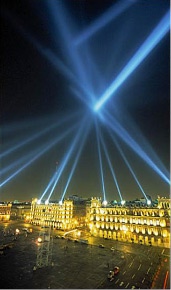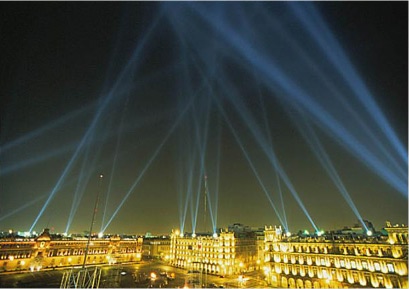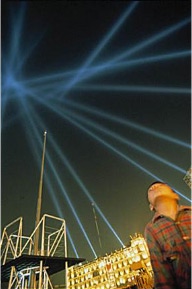 |
Mark Sussman, "Lighting Urban Spectacle: Electric Interventions in Everyday Life" Excerpts
from a talk given in the “Sensing the City” series
at the Canadian Centre for Architecture [draft,
not for citation] Immersing myself in the Sense of the City exhibit at the Canadian Centre for Architecture, I am stunned at the resonance between the surprising diversity of materials, the attention to multisensory atmospheric design, and Walter Benjamin’s language of the urban sensorium in a 1925 fragment from his urban dreamscape, One Way Street. This is not an exhibit of objects under light offered for extended, clinical contemplation. Rather, it alerts us to our sensory experience of the city by interrupting perceptual flows, disrupting our consumptive habits, and radically corrupting the senses with one another. Benjamin’s “This Space For Rent” is a one-paragraph essay in miniature. The space in question is the space of critical writing as much as it is the rentable space of the billboard. “Fools lament the decay of criticism,” he begins, “For its day is long past.” Embedded here is a critique of classical notions of authoritative critical writing and attending notions of critical reading, in which one might include vestigial habits of urban spectatorship. “Now things press too urgently on human society. The ‘unclouded,’ ‘innocent’ eye has become a lie, perhaps the whole naïve mode of expression sheer incompetence.” Writing in the 1920s with the newly felt impact of cinema, advertising, and commodity display in mind, Benjamin quietly and subtly disqualifies the contemplative criticism and distanced spectatorship that ignore the senses. Sensuous criticism, on the other hand, will meet the billboard, the printed flyer, the advertisement, and the lightning shock-effect of montage halfway, imitating their multi-sensory modes of attack; and so, perhaps, exhibitions that address the senses as well. “Today, the most real, mercantile gaze into the heart of things is the advertisement. It tears down the stage upon which contemplation moved, and all but hits us between the eyes with things as a car, growing to gigantic proportions, careens at us out of a film screen.” Advertising grows tactile, employing rhythm, scale, and speed. The eye becomes an extension of the hand. Critical distance gives way to immersive experience punctuated by the shocks of urban life. My thoughts here on lighting and electricity as they appear in various historical performances suggest some points of origin for our technological sense of the fabric of everyday urban life. With Benjamin, I hope to show that electrical phenomena have a long, even pre-modern history of collapsing the visual and the tactile and have only recently been relegated to what we absentmindedly call “the visual,” as if separate from the tactile, or the linguistic. As Benjamin reminds us, seeing dissolves into touch; the senses are inseparable, especially in that curiously receptive state in which we find ourselves when bored, waiting, overwhelmed, or distracted, a state that anthropologist Michael Taussig describes as “a very different apperceptive mode, the type of flitting and barely conscious peripheral vision perception unleashed with great vigor at the crossroads of the city, the capitalist market, and modern technology.” “What, in the end, makes advertisements so superior to criticism?” Benjamin asks. “Not what the moving red neon sign says – but the fiery pool reflecting it in the asphalt.” I thought of the fiery pool – semantic meaning dissolved into liquid and light – when David Howes asked if I would contribute to a lecture series occasioned by the Senses exhibit, by turning to its history, as a new form of urban spectacle which produces distracted inhabitants of an electrified urban landscape. II - Modern Light In “Konvolut T,” the file in Walter Benjamin’s famously unfinished Arcades Project bearing the label “Modes of Lighting,” this entry from 1852 on the sensory experience of Paris by gaslight appears: ‘What a splendid invention this gas lighting is![…] In how many different ways has it not enriched the festive occasions of life (not to mention its infinite importance for our practical needs.)!’ […] for, thanks to this general illumination, urban nighttime itself becomes a sort of ongoing animated festival[…] The
Arcades themselves, obsolete at the time of Benjamin’s research
in the Bibliotheque Nationale reading rooms in Paris in the 1930s,
represented this modern, and yet already outmoded, festivity,
eclipsed by newer urban formations of commodity display and street
life. By the end of the nineteenth century, the animating force
of festivity, electricity, promised urban safety, instant delivery
of lights and sounds, and better controlled forms of amusement
and spectacle, all tinged with a palpable aura of danger and anxiety.
“I reached the Champs-Elysées, where the cafés
concerts seemed like blazing hearths among the leaves,”
Guy de Maupassant writes of the Paris streets a half century later,
in 1909: Turner’s Regulus (1828) depicts a vision of blinding sunlight, in which water, sky, and horizon disappear into abstract, watery color. This romantic vision of the sun as vortex, overloading the senses to the point of blindness, evokes Edmund Burke’s idea that experiences of the sublime – joy, awe and terror of all kinds, not least the political terror of authority – depends as much on darkness, concealment, and what he refers to as a “judicious obscurity” as it does on the revelatory effects of enlightenent. “Extreme light,” Burke writes, “by overcoming the organs of sight, obliterates all objects, so as in its effect exactly to resemble darkness.” Compare Edvard Munch’s Le Soleil (1912), in which the sun’s rays are rendered as bursts of energy, an invisible rain of photons perceptible to the nervous sensibility of the modern city-dweller, an X-ray of Turner’s misty, romantic sun. And Giacomo Balla’s Futurist Lampe (dated 1909, though painted a year or two later) outshines the crescent moon, triumphantly replacing natural light with the otherworldly glow of urban streetlight. The field of Light Art expands by the day, as light is for many artists the ideal medium for illuminating our very processes of perception. Made from single-wavelength light sources, not unlike urban streetlights, Eliasson’s sun reflects only one frequency of the spectrum, rendering everything else in grays and blacks, enabling the visitor to perform Turner’s vision of Burke’s blindness by draining the color from familiar objects and other people, paradoxically using light to create monochrome landscape populated by urban sunbathers. Overhead
mirrors and a fine mist permeating the space cause the ceiling
to effectively dissapear, producing clouds which accumulate over
the course of the day. Eliasson is interested in how cities mediate
our experience of the weather, and how museums mediate, and often
anaesthetize, our senses.
His installation was accompanied by questionnaires on the topic of the weather, and became, a bit like the productions of Christo and Jean-Claude, a popular advertising campaign with an art project at its center. Its subject was as much the spectator’s experience of visiting a museum as it was about replicating natural phenomena. In her survey of the history of installation art, Claire Bishop notes that Eliasson’s work signals a return to phenomenological concerns and strategies of dematerialisation of the Light and Space artists of the 1970s, while also foregrounding the individual’s sensation of the museum. The installation, free to the public, allowed the hall to become a gathering place, a space for what Benjamin calls, in a 1926 essay on his beloved collection of children’s books, “pure, imaginative contemplation,” a practice familiar to children when they play with soap bubbles, watercolors, magic lantern projectors – games where colors are transparent. “Their magic lies not in the colored object or in the mere dead color, but in the colored glow, the colored brilliance, the ray of colored light.” This brilliance, color, and reflective glow returns in Benjamin’s fiery neon pool. III - Torch Lights Nineteenth century experiences of artificial light depended on the construction of new power infrastructures and the creation of demand for this mysterious new commodity. From the Edison Electric Lighting Company’s torchlight parade inOctober, 1884, in which a 200 ampere dynamo, wiring system, and 300 lamps processed through New York on the occasion of a presidential campaign, to the Light Cathedral of Albert Speer and Eberhard von der Trappen, designed for the closing ceremonies of the 1936 Berlin Olympics as well as Nazi party rallies, lies a history of electric spectacle and urban festivity. Rafael Lozano-Hemmer’s 1999-2000 piece Vectorial Elevation: Relational Architecture 4 brings this genealogy to the present. Where the Edison company staged a parade to be viewed in linear fashion by spectators on the street and Speer’s light cathedrals were virtual architectural spaces meant to be inhabited. Vectorial Elevation was “an interactive art project originally designed to celebrate the arrival of the year 2000 in Mexico City's Zócalo Square.” Using an online, 3-D interface, anyone could design a light sculpture that would then be rendered by eighteen high-powered searchlights over the world’s third largest public square and the heart of Mexico’s nationalist landscape. Lozano-Hemmer’s pieces, often using large-scale projection in public spaces, distribute authorship to its audience while retaining the element of spectacle. For Edison, the lighting and power delivery system were the main attraction, though the underlying message was essentially advertising. For Speer, bodies were rigidly ordered, architecturally fixed, with the means of illumination hidden, as in a classical theater with fixed lines of sight and transmission of meaning. In Lozano-Hemmer’s open-ended, interactive projects, the body of the spectator is unpredictable, reactive, and creative. The remainder of this paper will focus on the bodily transformations that accompanied the electrification of public lighting, urban festivity, and the body in both artistic and everyday performances. […] |
